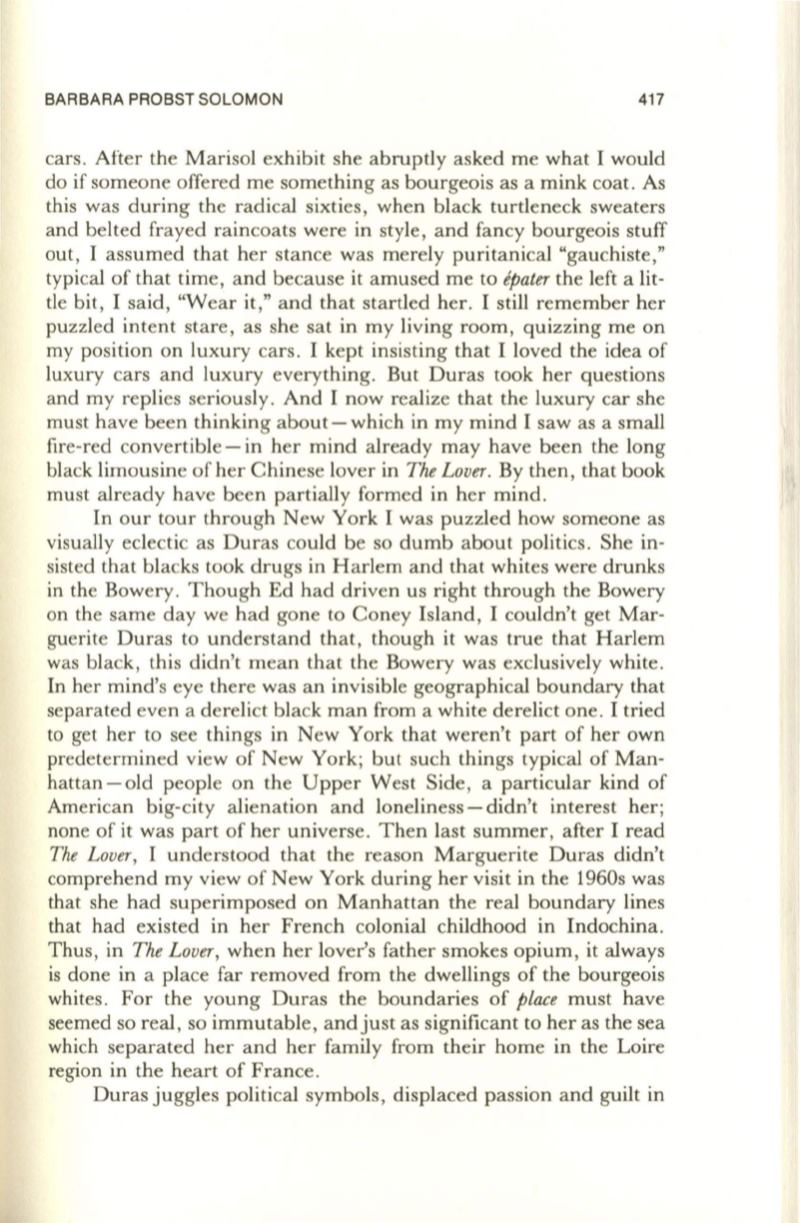
BARBARA PROBST SOLOMON
417
cars. After the Marisol exhibit she abruptly asked me what I would
do if someone offered me something as bourgeois as a mink coat. As
this was during the radical sixties, when black turtleneck sweaters
and belted frayed raincoats were in style, and fancy bourgeois stuff
out, I assumed that her stance was merely puritanical "gauchiste,"
typical of that time, and because it amused me to
epater
the left a lit–
tle bit, I said, "Wear it," and that startled her. I still remember her
puzzled intent stare, as she sat in my living room, quizzing me on
my position on luxury cars. I kept insisting that I loved the idea of
luxury cars and luxury everything. But Duras took her questions
and my replies seriously. And I now realize that the luxury car she
must have been thinking about-which in my mind I saw as a small
fire-red convertible - in her mind already may have been the long
black limousine of her Chinese lover in
The Lover.
By then, that book
must already have been partially formed in her mind.
In our tour through New York I was puzzled how someone as
visually eclectic as Duras could be so dumb about politics. She in–
sisted that blacks took drugs in Harlem and that whites were drunks
in the Bowery. Though Ed had driven us right through the Bowery
on the same day we had gone to Coney Island, I couldn't get Mar–
guerite Duras to understand that, though it was true that Harlem
was black, this didn't mean that the Bowery was exclusively white.
In her mind's eye there was an invisible geographical boundary that
separated even a derelict black man from a white derelict one. I tried
to get her to see things in New York that weren't part of her own
predetermined view of New York; but such things typical of Man–
hattan-old people on the Upper West Side, a particular kind of
American big-city alienation and loneliness - didn't interest her;
none of it was part of her universe. Then last summer, after I read
The Lover,
I understood that the reason Marguerite Duras didn't
comprehend my view of New York during her visit in the 1960s was
that she had superimposed on Manhattan the real boundary lines
that had existed in her French colonial childhood in Indochina.
Thus, in
The Lover,
when her lover's father smokes opium, it always
is done in a place far removed from the dwellings of the bourgeois
whites. For the young Duras the boundaries of
place
must have
seemed so real, so immutable, and just as significant to her as the sea
which separated her and her family from their home in the Loire
region in the heart of France.
Duras juggles political symbols, displaced passion and guilt in


